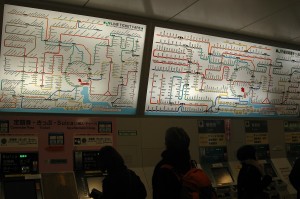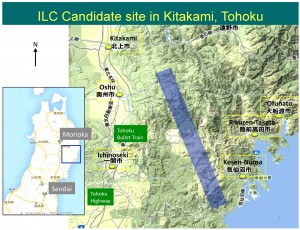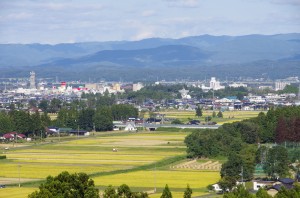Our mission was clear: we were the tasters, the vanguard. In early February, the two European LC communicators travelled to Japan for three days to a. find our way around the Japanese transport system, b. be filmed doing so, c. find entry points of improvement potential for foreigners about to make the same experience, and d. start a communication model for the future multi-national laboratory. Our itinerary: land at Haneda International Airport, take Monorail and local train to Tokyo train station for a Shinkansen high-speed train to Ichinoseki, some 450 kilometres further north. In and around Ichinoseki we were to visit various sites and sights – sites for the ILC if it was built there, and sights of the area to explore the leisure potential of Kitakami. Please see our “Kitakami glossary” for explanations of terms.
Here is how it all played out.
Our Japanese colleague Rika Takahashi asked us to fly to Haneda airport as it is supposed to become more of an international hub for the Tokyo Olympics in 2020 and might thus be a main entry port for ILC scientists in the future. (There is an airport closer to the Kitakami site, in Sendai and Hanamaki, which are serviced by flights from Osaka, so that’s another viable option next to Tokyo’s Narita airport) Detail for geeks: you get to ride downtown on the Tokyo Monorail!

European LC communicators in Tokyo, trying to find their way in the Japan Rail (JR) system. Image: ILC/ Barbara Warmbein.
One minor Tokyo public transport system culture shock later, we were zooming northwards on the Tohoku Shinkansen bullet train. Another treat for train geeks: the Hayabusa E5 Shinkansen runs on this line, and as of March the new E7 will take up operation. Look it all up here. But that’s enough about passenger trains – let’s move on to bunch trains.
The ILC, if built in the Kitakami region, would stretch from a part of Oshu called Esashi (one end of the linac) to a part of Ichinoseki called Morone (the other end of the linac), crossing under the rolling hills of Kitakami for beams to collide near the town of Ohara, under a mountain called Hayamayama. For the 1-TeV 50-kilometre option it would almost stretch out to the coast, to a town called Kesennuma – one of the towns that was severely hit by the March 2011 earthquake and tsunami. So the kind people from the prefecture office drove us around to places in the area where the international ILC lab could be established, showing us points for access tunnels, campuses, even the granite core probes that were taken to examine the exact geological situation of the area and are being evaluated now.
We also met with local officials and discussed how ILC scientists and the ILC could be attracted to the area, heard about their plans to open the region up to a massive new science project, visited local sights and admired the support for the ILC that can be spotted at many different places. The taxi driver who took us to our hotel, for example, said the ILC was “talk of the town”; shops had banners and pins, roads had signs. It was almost touching and certainly very exiting to see so much enthusiasm and support. As always, discussions led to more questions and things that would need to be investigated and done and conclusions are hard to draw, but we can conclude this: that the trip was an eye-opener for this area of Japan, that regional support should meet global support, and that foreigners – even plagued by jetlag – can easily find their way up to Kitakami.
バーバラ・ワームベイン (Barbara Warmbein)



The continuing threat of the Fukushima disaster seems to be of no consequence in the ILC’s siting, or am I missing something?
Thank you for your interest in the ILC project.
The accident at the Fukushima nuclear plant has no impact on the site selection of ILC.
The selection of the ILC candidate site in Japan has carried out according to purely scientifical and objective criteria.
In particular, the site has been selected based on suitable geological criteria as well as on socio-economic aspects.
It includes a risk assessment on various aspects.The radiation level around the candidate site is the same as it was
before the Fukushima accident, and therefore it was not considered as a risk factor at all.
We hope this clarifies your concern.
Dear Barbara, Perrine, and Rika
Many thanks for all fantastic articles specially issued, this week, for
the European Communicator’s visit to Tohoku. Your eyes are very fresh, and catch everything with some new angle and difference from just a scientist or technical person’s view points. I would thank you for your view as communicator’s, and family member’s view point, in case that the ILC happen, and smart lady’s sensitivities.
I would appreciate very much your journey and visiting Tohoku, and I would also thank your family to have kindly encourage your trip to Tohoku.